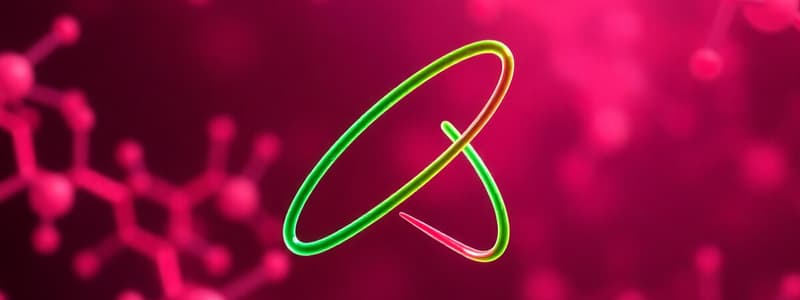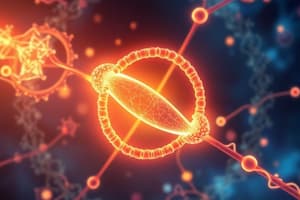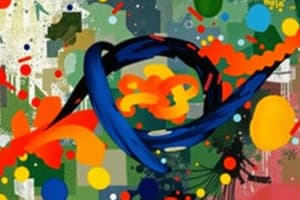Podcast
Questions and Answers
What is the primary function of adenosine triphosphate (ATP) in biological systems?
What is the primary function of adenosine triphosphate (ATP) in biological systems?
- It aids in the formation of cell membranes.
- It regulates cellular pH levels.
- It stores genetic information.
- It serves as a universal energy currency. (correct)
What happens when a high-energy phosphoanhydride bond in ATP is broken?
What happens when a high-energy phosphoanhydride bond in ATP is broken?
- It transforms ATP into adenosine monophosphate (AMP).
- It releases energy that can be utilized for cellular work. (correct)
- It increases the kinetic energy of surrounding molecules.
- It causes the molecule to become unstable and decompose.
What is produced alongside adenosine diphosphate (ADP) during the hydrolysis of ATP?
What is produced alongside adenosine diphosphate (ADP) during the hydrolysis of ATP?
- Glucose and carbon dioxide
- Acetyl CoA and oxygen
- Amino acids and fatty acids
- Inorganic phosphate group (Pi) and energy (correct)
Which of the following components does adenosine triphosphate (ATP) NOT contain?
Which of the following components does adenosine triphosphate (ATP) NOT contain?
In glycolysis, which biological process utilizes the energy released from the hydrolysis of ATP?
In glycolysis, which biological process utilizes the energy released from the hydrolysis of ATP?
What is the primary function of Acetyl CoA in the citric acid cycle?
What is the primary function of Acetyl CoA in the citric acid cycle?
During glycolysis, how many ATP molecules are ultimately gained?
During glycolysis, how many ATP molecules are ultimately gained?
Which of the following substrates transfers a high-energy phosphoryl group to ADP to form ATP during glycolysis?
Which of the following substrates transfers a high-energy phosphoryl group to ADP to form ATP during glycolysis?
What role does NAD+ play during glycolysis?
What role does NAD+ play during glycolysis?
Which enzyme is involved in the phosphorylation of glyceraldehydes-3-phosphate during glycolysis?
Which enzyme is involved in the phosphorylation of glyceraldehydes-3-phosphate during glycolysis?
How is energy harvested during glycolysis?
How is energy harvested during glycolysis?
What is the end product of glycolysis in terms of the number of pyruvate molecules produced?
What is the end product of glycolysis in terms of the number of pyruvate molecules produced?
What component is released and recycled after Acetyl CoA donates its acetyl group to the citric acid cycle?
What component is released and recycled after Acetyl CoA donates its acetyl group to the citric acid cycle?
What is the result of the reaction MH2 + NAD+ in the electron transport chain?
What is the result of the reaction MH2 + NAD+ in the electron transport chain?
What is the primary function of insulin in carbohydrate metabolism?
What is the primary function of insulin in carbohydrate metabolism?
Which enzyme complex is known as cytochrome reductase bc?
Which enzyme complex is known as cytochrome reductase bc?
How many ATP molecules are produced by the re-entry of hydrogen ions through ATP synthetase?
How many ATP molecules are produced by the re-entry of hydrogen ions through ATP synthetase?
During which metabolic process is pyruvate converted to acetyl-CoA?
During which metabolic process is pyruvate converted to acetyl-CoA?
Which of the following is NOT a monosaccharide?
Which of the following is NOT a monosaccharide?
What is the final product when oxygen reacts with 2 electrons and 2 hydrogens in the mitochondria?
What is the final product when oxygen reacts with 2 electrons and 2 hydrogens in the mitochondria?
During the conversion of 2 pyruvate molecules to 2 acetyl CoA, how many ATP are generated from NADH?
During the conversion of 2 pyruvate molecules to 2 acetyl CoA, how many ATP are generated from NADH?
What is the total amount of ATP produced from one molecule of glucose through carbohydrate metabolism?
What is the total amount of ATP produced from one molecule of glucose through carbohydrate metabolism?
Which vitamins are essential as coenzymes in carbohydrate metabolism?
Which vitamins are essential as coenzymes in carbohydrate metabolism?
What is the state of iron ions in the heme structure before they receive electrons?
What is the state of iron ions in the heme structure before they receive electrons?
What does coenzyme QH2 carry in the electron transport chain?
What does coenzyme QH2 carry in the electron transport chain?
What is a key metabolic consequence of pyruvate entering the Krebs cycle?
What is a key metabolic consequence of pyruvate entering the Krebs cycle?
Which body cells are primarily responsible for storing glucose as glycogen?
Which body cells are primarily responsible for storing glucose as glycogen?
What type of phosphorylation occurs in glycolysis that yields 2 ATP?
What type of phosphorylation occurs in glycolysis that yields 2 ATP?
Under anaerobic conditions, what substance is produced from pyruvate?
Under anaerobic conditions, what substance is produced from pyruvate?
What happens to pyruvate under aerobic conditions?
What happens to pyruvate under aerobic conditions?
Which of the following is NOT one of the enzymes involved in the conversion of pyruvate to acetyl CoA?
Which of the following is NOT one of the enzymes involved in the conversion of pyruvate to acetyl CoA?
What is the outcome of pyruvic acid conversion during strenuous activity?
What is the outcome of pyruvic acid conversion during strenuous activity?
What is the primary function of the citric acid cycle?
What is the primary function of the citric acid cycle?
How many coenzymes are involved in the conversion of pyruvate to acetyl CoA?
How many coenzymes are involved in the conversion of pyruvate to acetyl CoA?
Which coenzyme is derived from riboflavin?
Which coenzyme is derived from riboflavin?
What type of bond links the acetyl group to coenzyme A in the formation of acetyl CoA?
What type of bond links the acetyl group to coenzyme A in the formation of acetyl CoA?
What process occurs when the formation of ketones exceeds the ability of tissues to oxidize them?
What process occurs when the formation of ketones exceeds the ability of tissues to oxidize them?
What process converts lactic acid back to pyruvic acid during the resting period?
What process converts lactic acid back to pyruvic acid during the resting period?
Which of the following is primarily required for lipogenesis?
Which of the following is primarily required for lipogenesis?
What is the primary site of triglyceride synthesis in the body?
What is the primary site of triglyceride synthesis in the body?
What is the primary function of cellular respiration?
What is the primary function of cellular respiration?
Which process results in the breakdown of glycogen to glucose?
Which process results in the breakdown of glycogen to glucose?
During which metabolic process is citric acid broken down in mitochondria?
During which metabolic process is citric acid broken down in mitochondria?
Which metabolic process describes the formation of glucose from amino acids and fats?
Which metabolic process describes the formation of glucose from amino acids and fats?
What process is described as the anaerobic breakdown of glucose yielding two ATP?
What process is described as the anaerobic breakdown of glucose yielding two ATP?
Flashcards
ATP
ATP
Adenosine triphosphate; a molecule that stores and releases energy for cellular processes.
Nucleotide
Nucleotide
A molecule made of a nitrogenous base, a five-carbon sugar, and one, two, or three phosphate groups.
High-energy bond
High-energy bond
A chemical bond that releases a significant amount of energy when broken.
ATP Hydrolysis
ATP Hydrolysis
Signup and view all the flashcards
Catabolism
Catabolism
Signup and view all the flashcards
Pyruvate to Acetyl CoA conversion
Pyruvate to Acetyl CoA conversion
Signup and view all the flashcards
Pyruvate Dehydrogenase Complex
Pyruvate Dehydrogenase Complex
Signup and view all the flashcards
Citric Acid Cycle (Krebs Cycle)
Citric Acid Cycle (Krebs Cycle)
Signup and view all the flashcards
Aerobic Condition
Aerobic Condition
Signup and view all the flashcards
Anaerobic Condition
Anaerobic Condition
Signup and view all the flashcards
Gluconeogenesis
Gluconeogenesis
Signup and view all the flashcards
Glycolysis
Glycolysis
Signup and view all the flashcards
Oxidative Phosphorylation
Oxidative Phosphorylation
Signup and view all the flashcards
Acetyl CoA
Acetyl CoA
Signup and view all the flashcards
Citric Acid Cycle
Citric Acid Cycle
Signup and view all the flashcards
Substrate-level phosphorylation
Substrate-level phosphorylation
Signup and view all the flashcards
Pyruvate
Pyruvate
Signup and view all the flashcards
Monosaccharides
Monosaccharides
Signup and view all the flashcards
Krebs Cycle
Krebs Cycle
Signup and view all the flashcards
Electron Transport Chain
Electron Transport Chain
Signup and view all the flashcards
Insulin
Insulin
Signup and view all the flashcards
Glycogen
Glycogen
Signup and view all the flashcards
Electron Transport Chain (ETC)
Electron Transport Chain (ETC)
Signup and view all the flashcards
ETC Complex 1
ETC Complex 1
Signup and view all the flashcards
ETC Complex 3
ETC Complex 3
Signup and view all the flashcards
ETC Complex 4
ETC Complex 4
Signup and view all the flashcards
ATP Synthase
ATP Synthase
Signup and view all the flashcards
Proton Gradient
Proton Gradient
Signup and view all the flashcards
ATP Yield from Glucose
ATP Yield from Glucose
Signup and view all the flashcards
Ketosis
Ketosis
Signup and view all the flashcards
Lipogenesis
Lipogenesis
Signup and view all the flashcards
Catabolism (Metabolism)
Catabolism (Metabolism)
Signup and view all the flashcards
Cellular Respiration
Cellular Respiration
Signup and view all the flashcards
Glycogenolysis
Glycogenolysis
Signup and view all the flashcards
Glycogenesis
Glycogenesis
Signup and view all the flashcards
Study Notes
Metabolism of Biomolecules
- Energy is crucial for cellular functions like movement, transport, biosynthesis, and mechanical work
- Fuel molecules (carbohydrates, fats, proteins) are the major sources of energy
- Breakdown of food fuels into smaller units (catabolism) precedes energy production
- The process of catabolism involves many chemical reactions which are collectively called metabolism
- ATP (adenosine triphosphate) is the cellular energy currency
- ATP is a nucleotide composed of a nitrogenous base (adenine), a five-carbon sugar (ribose), and one, two, or three phosphate groups.
- Hydrolysis (breakdown) of ATP releases energy, essential to drive cellular functions
- Catabolic pathways break down complex molecules to simpler ones, releasing energy in the process.
- The process occurs in stages:
- Stage 1: Hydrolysis of macromolecules into subunits.
- Stage 2: Conversion of subunits into acetyl-CoA.
- Stage 3: Complete oxidation of acetyl-CoA to produce ATP.
ATP Structure
- ATP consists of adenine, ribose, and three phosphate groups joined by phosphoanhydride bonds
- The phosphoanhydride bonds are high-energy bonds; breaking them releases a significant amount of energy
Catabolic Processes
- Carbohydrates, fats, and proteins are broken down into simpler molecules
- The initial steps of catabolism involve the breakdown of complex molecules into their simpler subunits, such as glucose, fatty acids, and amino acids.
- Catabolic processes are divided into three stages.
- Stage 1: Hydrolysis of macromolecules like proteins, carbohydrates, and fats into smaller units such as amino acids, simple sugars and fatty acids, and glycerol.
- Stage 2: Conversion of these subunits into a common intermediate form, acetyl-CoA.
- Stage 3: Complete oxidation of acetyl-CoA through the citric acid cycle and oxidative phosphorylation to generate ATP.
Glycolysis
- Glycolysis is an anaerobic breakdown of glucose into two pyruvate molecules
- It occurs in the cytoplasm
- Two ATP molecules are produced per glucose molecule, which is called substrate-level phosphorylation
- NAD+ is reduced to NADH, which plays a critical role in the later stages of energy production
- The end product of glycolysis, pyruvate, can be further processed in aerobic conditions (presence of oxygen), to produce Acetyl-CoA for the citric acid cycle. Or in anaerobic conditions (absence of oxygen) pyruvate is converted into lactic acid
Conversion of Pyruvate to Acetyl-CoA
- Pyruvate is converted into Acetyl-CoA, losing a carbon dioxide molecule
- This conversion is the connection between glycolysis and the citric acid cycle
- NAD+ is reduced to NADH, another crucial step in energy production.
- The product Acetyl-CoA carries the carbon atoms into the citric acid cycle.
Citric Acid Cycle (Krebs Cycle)
- Acetyl-CoA enters the citric acid cycle, a series of reactions in the mitochondrial matrix
- The cycle completes the oxidation of the acetyl group, releasing carbon dioxide and producing high-energy electron carriers (NADH and FADH2)
- Guanosine triphosphate (GTP) is also generated
- The cycle turns twice for each glucose molecule that entered glycolysis
- The citric acid cycle is crucial because it generates high-energy electron carriers that are utilized for ATP production in aerobic respiration and is a major source of precursors for biosynthetic pathways
Oxidative Phosphorylation (Electron Transport Chain)
- This process extracts energy from NADH and FADH2 to generate ATP.
- Involves a series of protein complexes embedded in the inner mitochondrial membrane
- Electrons carried by NADH and FADH2 are passed along the chain, releasing energy that is used to pump protons (H+) across the membrane
- The H+ gradient that forms drives ATP synthesis by ATP synthase
- Oxygen acts as the final electron acceptor, forming water
- The process generates a large amount of ATP (approximately 32-34 ATP per glucose molecule).
Major Metabolic Pathways Converging on the TCA Cycle
- Many different pathways provide molecules that enter the TCA cycle.
- Glycolysis, fatty acid breakdown, and amino acid catabolism converge on acetyl CoA, supplying carbon atoms for the citric acid cycle.
Regulation of Metabolic Pathways
- Enzymes within the pathways are frequently regulated through allosteric control or feedback inhibition.
Studying That Suits You
Use AI to generate personalized quizzes and flashcards to suit your learning preferences.
Related Documents
Description
This quiz delves into the crucial processes of metabolism and energy production within cells. It covers the breakdown of biomolecules like carbohydrates, fats, and proteins, leading to ATP synthesis. Understand the stages of catabolism and the role of ATP as the energy currency of the cell.



